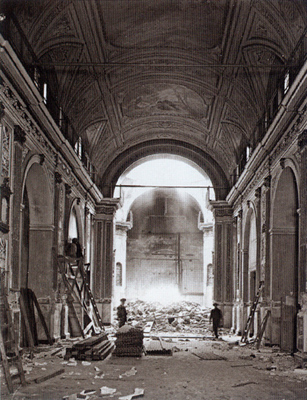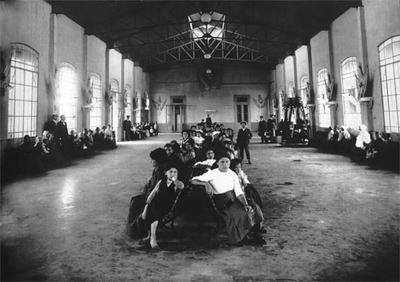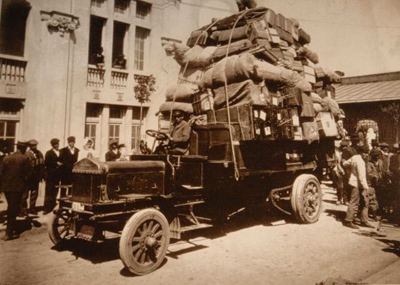
When historians look back on Buenos Aires at the turn of the 21st century, one of the topics they will likely discuss is the unfortunate destruction of the city’s architectural heritage. Nothing seems to be able to stop it.
Buenos Aires began to take on its current look around 1890… so architecturally, the city is relatively young. Colonial structures failed to survive due to poor building materials, & Torcuato de Alvear removed older buildings to give the city a more European air. He left a legacy that travel writers would run into the ground, calling BA “the Paris of South America”… much to everyone’s chagrin these days.
But local government continually fails to see how architectural heritage contributes to the city’s image or income. Grassroots organizations like Basta de Demoler have fought against demolitions since Mauricio Macri became mayor in 2007. He blocks all efforts to preserve one of the city’s most distinguishing characteristics. Beyond the bitching & complaining which normally accompanies this topic, I’ve often wondered about its real cause. Most of my friends love local architecture, but there is obviously a majority who don’t care if anything in the city survives. And although powerful, greed alone cannot account for so much disregard… it must go deeper than that.
Maybe I’ve found part of the answer. I recently finished a book titled “The Collective Memory Reader,” a fantastic collection of essays about what memory is, how it interacts with past & present, our group identities (national or otherwise) & how we choose to remember events collectively. At almost 500 pages, it was meant for university study but it caught my attention & really explained a lot about Buenos Aires… even though none of the essays directly address BA or Argentina.
One essay which stood out was written by Roger Bastide in 1978:
Since memories are psychic by nature, if they are to survive they must survive in something durable; they must be attached to a permanent material base of some kind… Place, society, actions, and memory now become one…
His study focused on the disappearance of African traditions in Brazil based on place removal. Since traditions often develop with respect to their natural environment, take away the place & many old traditions become irrelevant. I thought: why not apply the same theory to the millions of immigrants who arrived in Argentina from 1880 to 1920?

During that time, Buenos Aires assumed its role as capital of Argentina —only officially recognized in 1880. With internal conflicts finally resolved, the first attempts to build national & local collective memory began 70 years after breaking away from Spain. That’s a long time to wait. But the problem goes deeper. All those European-style monuments were erected to people, places & events to which recently arrived immigrants had no attached meaning. The city’s beautification only served the landed elite. As the oligarchy paid homage to themselves & built fantastic palaces to live in, millions of new Argentines could not understand the message… nor had reason to adopt it.
I imagine that first-generation Argentines born of immigrant parents would have had a bit more attachment with the nation, but probably not until the second generation would there be any real feeling of being Argentine. Interestingly enough, that time frame corresponds with the Perón era. Could those second generation immigrants have identified with Perón in part because they were looking for a way to develop their own collective memory? Torn between ancestors who felt ties to Europe but knowing they themselves would probably never see those places? It’s an interesting coincidence.

I remember how my ex’s grandmother never obtained her Argentina passport & likewise never voted in national elections. It wasn’t important to her, & maybe she thought of herself more as Spanish than Argentine. Very likely. How many cases like that were there? This detachment may explain, in part, why Argentina had such a messy 20th century. There were two sets of collective memory at odds with each other. Everyone I know is proud to be Argentine today, but when push comes to shove they leave for Europe or elsewhere.
Even today —more than a century later— many argentinos say: “my grandparents were Italian” or “I have ancestors from Asturias.” Guess what. You’re Argentine now. Shouldn’t that be more important? I’m certainly proud my ancestors were from the UK. But I would never bring it up in a general conversation like they do here. UK readers: Love you all. Seriously. Miranda Hart: Love you most. But I’m American. I learned patriotic songs as a kid, I love the mythology of the US (however erroneous it may be), & I love feeling part of something larger than myself. That particular collective identity formed when I was a child & it hasn’t seemed to fade. But after living 11 years in Buenos Aires, I’ve never heard anyone here say something similar.

That’s where Argentina seems to have failed. The collective memory of the oligarchy did not adapt to include immigrants. And those immigrants held tight to memories they could not pass on. Their children were caught in an identity crisis that is still visible today. Official attempts to revise history & demonization of anyone who disagrees with their cause are two recent examples of that conflict. Such unhealthy policies continue to prevent the formation of any type of collective bond.
I would love to see (or do myself… with a grant, thank you) a study of what monuments or statues were built, when, how much they cost, who paid for them, how many times were they moved & the significance of their location. Tie that info to population stats & income levels of the barrios where the monuments are. What monuments are missing? What kind of attendance do the few commemorative events have? The answers could reveal some surprises.
Most academics have come to the conclusion that blatant nationalism leads to no good. I would agree. But what about a nation that has no collective memory? One of the consequences might be a lack of respect for national heritage… most visible via the demolition of the capital city’s architecture. Food for thought anyway.
Amazing post, Robert.
Thanks, Daniel! I’ve been fascinated with collective memory studies for the past few months, & it’s surprising how much it explains about Argentina. Saludos!
Dear Robert,
Interesting reading, thanks to contacts we have in common on FB! It is a breath of fresh air to read well informed, argued opinions and conclusions. So I trust you will take the following with the understanding of someone who can take argued, respectful (partial) disagreement. I am not referring to the lack of cultural patrimony self-preservation interest and policies, because I totally agree with that (I won’t even get started on the current Governor…), but to your conclusion on the lack of Argentine collective memory.
I believe seeing all that you do see is really valuable, as it is the basics towards understanding the Argentine identity. Seeing only this, though, would lead to missing out all the complexity of the (re)construction of the Argentine identity since the foundation of this nation state up to date. What you observe is absolutely part of the Argentine identity. But I believe it has nothing to do with a lack of collective memory. It’s there, but just very different and very differently constructed from the one in your or my country of origin.
There’s no text-book to follow in order to build national identity and THUS collective memory; in fact recipes have widely varied worldwide. Here, it was quite simple and as MADE UP as everywhere else: establish a raw model hence an elite, suppress the social categories that do not fit it, invent a cultural pattern. It happened in Europe, in the USA and in Latin America. In this country, very roughly summed up, it translated into mixing up oligarchy with criollos, denying the prevalence of the indigenous people and the existence of an African descent, and centering the spirit root-myth on the gaucho.
Now, however, as of the end of the 19th century, the main figures that made the argentinidad tick and roll have been immigrants. Not just any type of immigrants? Of course not. There was in fact a recipe that pursued, just like in every nation state’s creation, the accomplishment of a certain “imagined community”, as Benedict Anderson calls it. And they did follow that recipe that promised to achieve just that, again, like everywhere else, through a social construction (big part of it reflected in monuments, for instance).
Immigrants –from so many different places, so heterogeneous, yet all exiled- have been precisely the core of the Argentine national identity as we know (and clash with) it today. And that is what makes it oh so full of contrasts and contradictory! But it is this inherent mélange of contrasts and contradictions which define Argentine national identity and what, along with this construction, have turned into collective memory. Argentine collective memory gathers that mélange, and yet find its equilibrium point towards cohesion in the one factor that exile meant to them and their ancestors. I like to call that, away from the botanic metaphor of “uprootedness”, simply nostalgia over the paradise lost. “I’m Spanish/ Italian/ French” has to do with that, I think.
But Argentines do recognize themselves as such, with a specific national identity and specific collective memories, besides just simple historical data. Otherwise, they wouldn’t stick together when facing a common external/ foreign obstacle and they would not mock themselves and their contradictions like a nation that knows damn well where it comes from and what it’s been through. Nicely put, food for thought, where they are going from here and what they’ll do with their past, reflected in both facts and architecture.
Thank you for reading. Enjoy this, son argentinos y están al palo 🙂
http://www.youtube.com/watch?v=6GL9AR76jKk
Hello Andra – Thanks very much for writing such an informative & detailed response. So many people lurk without saying anything, & it’s wonderful to hear a variety of opinions. BTW, I’m going to Bucharest in a month to see friends. I need to start learning some basic Romanian!!!
One thing I hadn’t remembered is the attempt to incorporate the romantic image of the gaucho into collective memory during the 1920s (hence all the great gauchesco literature like “Don Segundo Sombra“). I’m glad you mentioned it. To me, incorporating the ideal of the gaucho failed as well although at the same time, I think it was a valid attempt to construct a unique national identity.
Sarmiento & other idealists/racists 🙂 certainly had the notion of an “imagined community” in mind when they looked to Europe to populate the pampas. But they soon realized that idea failed. As I’m fond of saying, literally everyone came to Argentina… from trained professionals (best example would be all the architects who made BA beautiful) to unskilled workers. The oligarchy loved the trained professionals, but all those others… not so much. They realized their experiment was failing early on (the 1909 May Day demonstrations, the birth of the Liga Patriótica Argentina & the reverse immigration law designed to send anarchists back to their country of origin). So while the elite were celebrating what they saw as their own tradition & identity, the lower class didn’t seem to buy into it.
Something else which has always struck me as strange is that I’m only third-generation American, exactly like so many Argentines of my age. My ancestors arrived in the 1860s to the US, so a bit before mass immigration began in Argentina. Anyway, the USA is just as much of a melting pot as Argentina yet did a much more thorough job of incorporating immigrants. It would be interesting to find out how many US immigrants returned to their country of origin after “doing America” compared to Argentina. Here I think it was about 50%, but no clue as to US figures. I love your idea of nostalgia over paradise lost (especially since Europe wasn’t exactly a paradise when those immigrants arrived)… definitely worth exploring.
It’s funny… I see that mélange as preventing the formation of collective memory whereas you don’t. But perhaps that’s because I don’t always see national identity & collective memory as part of the same package. Sometimes yes, sometimes no. But like you say, it’s true that Argentines come together against outside threats & mock themselves. But when it comes to an internal package of shared information based on references to the past, I don’t quite see it here. But I’ll keep looking 🙂 Thanks again for one of the best comments I’ve had on the blog!!
***ROLE model
i meant
Robert, hi! Thank you!
I agree with every single word in your paragraph that tracks down racism and discrimination back to Sarmiento & co. And also with the idea that those immigrants’ Europe was already falling apart, far from being a paradise. But that is precisely it: most of those people thought they had first lost the European paradise (absolutely arguable there was one too) before they left… which is why they assumed they HAD TO leave. I think that is the main difference with many emigrant waves towards the US for example, where many “new rich” went to become richer and didn’t have to deal with such heterogeneous cultural ingredients for the melting pot until a lot later, when they were already consolidated. The immigrants who came to Argentina in the 19th century had already packed the too little or nothing they had together with a ton of loss. And they brought it in their luggage and passed it on to following generations as part of their DNA. Hence tango, just to name something obvious 🙂
I would absolutely love to talk about all this and go deeper into details with you. Till then, my gift to you is recommending some of the best Spanish written prose I’ve ever read personally, which also gives you a thorough grasp on how Argentines started becoming who they are. It’s called FRONTERA SUR and the author, HORACIO VÁZQUEZ-RIAL, is an Argentine who HAD TO leave in exile in Europe in the ‘70s, losing thus his own paradise lost 🙂
Thanks very much for the recommendation. I’ll definitely look for it if I get a chance to wander around Avda Corrientes in the next few days. That particular author isn’t on my radar… last year I tried to read as many Argentine classics as I possibly could. Made a good dent in the list, but there are still many more to go.
I believe many of the immigrants to the US were equally as poor as the ones who arrived in Argentina. At the time, it was pretty much a random choice: do we sail to the US or Argentina? 🙂 For ex, my ancestors were coal miners from near Manchester (god forbid… I was there about a year ago). Anyway, they did the same thing in the US, coal mining. Nothing glamorous about that. It’s interesting that Argentina had conventillos while the US had whole neighborhoods (like Little Italy in NYC)… I don’t know. There has to be something to that.
Anyway, my time is pretty tight over the next few days because we’re leaving on the 29th for Lisboa. But hopefully we can get together & chat soon. If not, definitely when we’re back in June. Saludos!
Pingback: Daily URL - February 20th - Baexpats - Community of Expatriates in Buenos Aires, Argentina
I do not agree with many statements that are presented here. First if all the eclectic architecture of Buenos Aires was not chosen, erected end enjoyed by the élite. On the contrary, much of the built environment of Buenos Aires is a unique mix not found elsewhere. And most of it is the will of inmigrants that wanted to recall their origins in terms of architecture or decoration but with the technical and functional adaptations that provided the New World. Another unique feature was the mix of architectural cultures not only witin the city but even inside a single building. For instance: it´s very common to find a French architect, an English engineer, Italian decorators and contractors, Belgian metal structure, Swiss heating systems German finishings shaping the new spaces of criollos or inmigrants… The big problem with conservation is the lack of appreciation of this architecture culture that starts from specialists(architects, historians, artists, intelectuals) follows with the descendants of the elite (they find this heritage as frivolous pastiche) and finishes in the citizens teenager´s attitude of selfishness and lack of interest.
The architecture culture of Buenos Aires of the late 19th and early 20th century is very much global, sophisticated and exceptional. Hard to understand, decodify and enhance…
Hello Mr. Grementieri – Thank you very much for taking the time to comment on my blog. I appreciate your opinion, & it was a surprise to find that you had read my post. But I do not claim that the eclectic architecture of BA was only built by the elite. The focus of my post was the construction of monuments (which was definitely controlled by the elite) & what effect that might have had on newly-arrived immigrants. The hypothesis is that a lack of collective memory—conveyed by building monuments to people that those immigrants did not know—might contribute to the lack of architectural preservation. It would affect every group you mentioned (specialists, descendants of the elite & citizens). As I read more & more about collective memory, the more I am convinced that it could help explain many of Argentina’s current problems. De todas formas, me parece que falta mucha investigación del tema. Gracias por escribir y espero tener otra oportunidad de hablar con Usted en el futuro.
Excellent article thanks — I agree with every word.
Great Work,
you have anything about the history of the hotel “Deutscher Bund” At Paseo De Julio 420 in Buenos Aires. Still existed in 1916.
Greetings from Bernhard Rohne, Vancouver,BC,Canada.
Hello Bernhard – Unfortunately I don’t have any information about that particular hotel. Paseo de Julio is now called Avenida Alem… was it one of these two buildings?

Hi Robert Thank you for your response. My family is originally from Argentina but of German origin. Yes it is the hotel on the left but it seems they have build it higher over time. My grandfather worked there as a porter after escaping a Brazilian internment to Buenos Aries as WW1 broke out. He returned to Germany aprox. 1920 leaving his family behind. I am trying to discover why.
Greetings from Bernhard Rohne
What a fascinating story, Bernhard… if you find out any more information, I’d love to hear about it!! Saludos!
You can see my Immigration story on my website under Video -” From Kaiser to Bauhaus”.
Greetings Bernhard Rohne